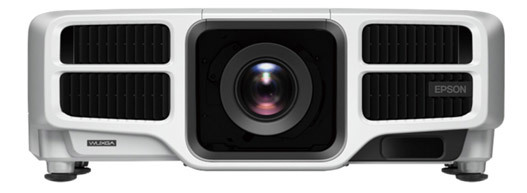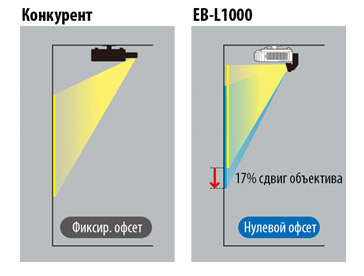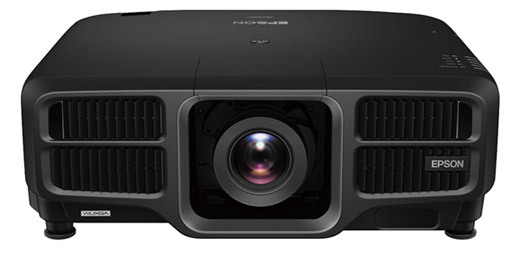Epson laser installation projectors. 56,000 hours without replacing the lamp - now reality
In the summer of 2016, deliveries of the first Epson L1000 series laser installation projectors began. In the line - models with a luminous flux from 6000 to 12000 lumens. The resolution is WUXGA (1920 × 1200, aspect ratio 16:10).
For more sensationalism, we hasten to inform you that the estimated lamp resource ranges from 20,000 to 56,000 hours! Here it is - the main "trick" of the new line.
Well, now consider the device closer.

The Epson L1000 series of laser projectors includes the following models:
Resolution | WUXGA | WUXGA | WUXGA | WUXGA | WUXGA | WUXGA |
Brightness | 6,000 lm | 7,000 lm | 8,000 lm | 8,000 lm | 12,000 lm | 12,000 lm |
Body color | White | White | White | The black | White | The black |
The start of deliveries is expected from July to September, depending on the specific model, and from October one more expected laser projector — Epson EB-L25000U with a luminous flux of 25,000 lumens — must “mature”! This post will focus on the L1000 series.
Up to 56000 hours
Speaking of projectors on a laser or LED-light source, no one will be surprised by the “source of light source estimated by the manufacturer at 20,000 hours”. This figure is written on all Chinese LEDs, and evaluation is a non-binding thing. Another thing - when the figure is inscribed in the warranty . So, Epson offers the following guarantee for projectors of the L1000 series: 5 years of operation or 20 thousand operating hours (which comes faster). Impressive, right?
This is ensured primarily by the use of inorganic materials in the key components of the projector: in the matrix, the light source and, most importantly, in the phosphor.
It's a big deal .
Accordingly, during this period no maintenance will be required to the projector, since these projectors use a new filter designed to operate for 20 thousand hours. Thus, the usual division of warranty conditions for “on the projector” and “on the lamp” for new Epson laser projectors is no longer relevant.
As for the statement “up to 56000 hours”, you probably know how the “Eco-mode” works for “lamp” projectors. Here everything is the same, but with one exception: the user can set any brightness, and the lower it is, the more additional hours of the light source you get. In the table below, along the Y axis, we have the brightness values from maximum to minimum, and horizontally, the duration of the light source.

In addition, such full control of the luminous flux is always a plus for the installer.
Another reliability factor associated with the use of a laser light source is that it consists of an array of diodes, and if one of them suddenly fails, the image will not disappear , and only the brightness will decrease slightly. Although the situation is hypothetical, but, all the same, it saves nerves, especially in this case.
Of course, new projectors can quietly work 24/7 and even officially intended for it.
')
Installation
L-Series projectors can be installed under any vertical and side slope without losing service life. This is extremely useful for use in complex installations, including video mapping .

Projectors have lens shift function. The claimed range is 67% of the image height up and down and 30% of the image width left / right. (For older models of the line - 60% and 18%, respectively).
The possibility of shifting is retained even when using interchangeable lenses, including the most short-focus lens, which has a projection ratio (the ratio of the distance from the lens to the screen to the screen width) of 0.35: 1, which is almost the lowest projection ratio of the ultra-short-focus lens for installation projectors!

In general, the range of interchangeable lenses for projectors of the L1000 series (except Epson L1500U and Epson L1505U) fully covers the range of projection ratios from 0.35 to 10: 1! All lens control is motorized; there is a lens memory function that allows you to instantly switch between various settings saved by the user. Projectors support image stitching and projecting onto complex surfaces: spherical type and angles.

Another feature of the EB-L1000 series of projectors is the presence of a built-in camera that allows you to automatically adjust the image while keeping the color rendition parameters unchanged. The camera is also used in the process of stitching images from multiple projectors. These are truly smart projectors.
Picture
Like all Epson projectors, the new laser projectors are based on three-matrix technology, namely - 3LCD. This allows the projector to achieve equally high maximum brightness (in white) and color brightness, which, in turn, gives the best image quality when the projector is operating in the brightest mode, where it delivers the lumens declared in the specification. We talked about this in one of our previous posts .
Of course, the resolution of WUXGA (1920 × 1200) is good. However, in the case of projectors, especially when it comes to really large image diagonals, the resolution is never too large. In this regard, all new Epson installation projectors with WUXGA resolution, not only laser ones, are equipped with the 4K Enhancement function, the task of which is not only to increase the resolution of the projector, but also to eliminate the pixel grid.
For those who have not yet heard the principle of operation of this technology, which came from the flagship model of home cinema projectors, we recall that the essence of "4K-improvements" is approximately as follows: every second frame the image is shifted by half-pixel diagonally, with the result that every A pixel is divided into four subpixels :

In essence, a visual field is created with 4K resolution. Although it is not possible to control each individual pixel of this field, nevertheless, it is possible to extract details from 4K content that could not be displayed on a full HD or WUXGA projector. This procedure is an effective weapon, eliminating the pixel grid in any form. Those. This is not a built-in “Unsharp mask”, but a real hardware and software solution that allows you to increase the perceived resolution of the projector.
Other supported features
Frame interpolation - L-series projectors allow high-quality insertion of intermediate frames into content shot and broadcast in the format of 30 frames per second or less, allowing, for example, to achieve high smoothness of background movements when the camera is moved. Read more - see a separate post .
Super Resolution technology not only enhances image sharpness, but also converts to 4K resolution for use with the 4K Enhancement feature.
Alignment of LCD panels - this function must necessarily be present with expensive three-matrix projectors. In case of detection of problems with the mixing of pixels, this function allows you to solve them.
Also, EB-L1000 laser projectors have compatibility with the following standards:
- Extron XTP based systems
- With DMX512 protocol for controlling stage equipment and lighting effects.
- With DMX Art-Net protocol ( EB-L1405U , EB-L1500U , EB-L1505U ) to realize the ability to smoothly control the brightness of the projector through the console

The future is here
The time of laser projectors has finally come. The first step was the High-End Home Theater Projector - Epson LS10000, now it's the turn of the installation models.
Of course, no one is going to give up the time-tested lamp projectors in the near future, and many laser projectors in the Epson line will have an analogue with a conventional lamp as a light source. In any case, 2016 will go down in the history of our company, as the year of the next confident step into the future in the field of VI-technologies. By the way, at the time of sale, Epson EB-L1500U and Epson EB-L1505U projectors are the brightest 3LCD laser projectors in the world (12000 lm). There is something to be proud of, isn't it?
Ready to answer any questions on the topic.
Source: https://habr.com/ru/post/396759/
All Articles